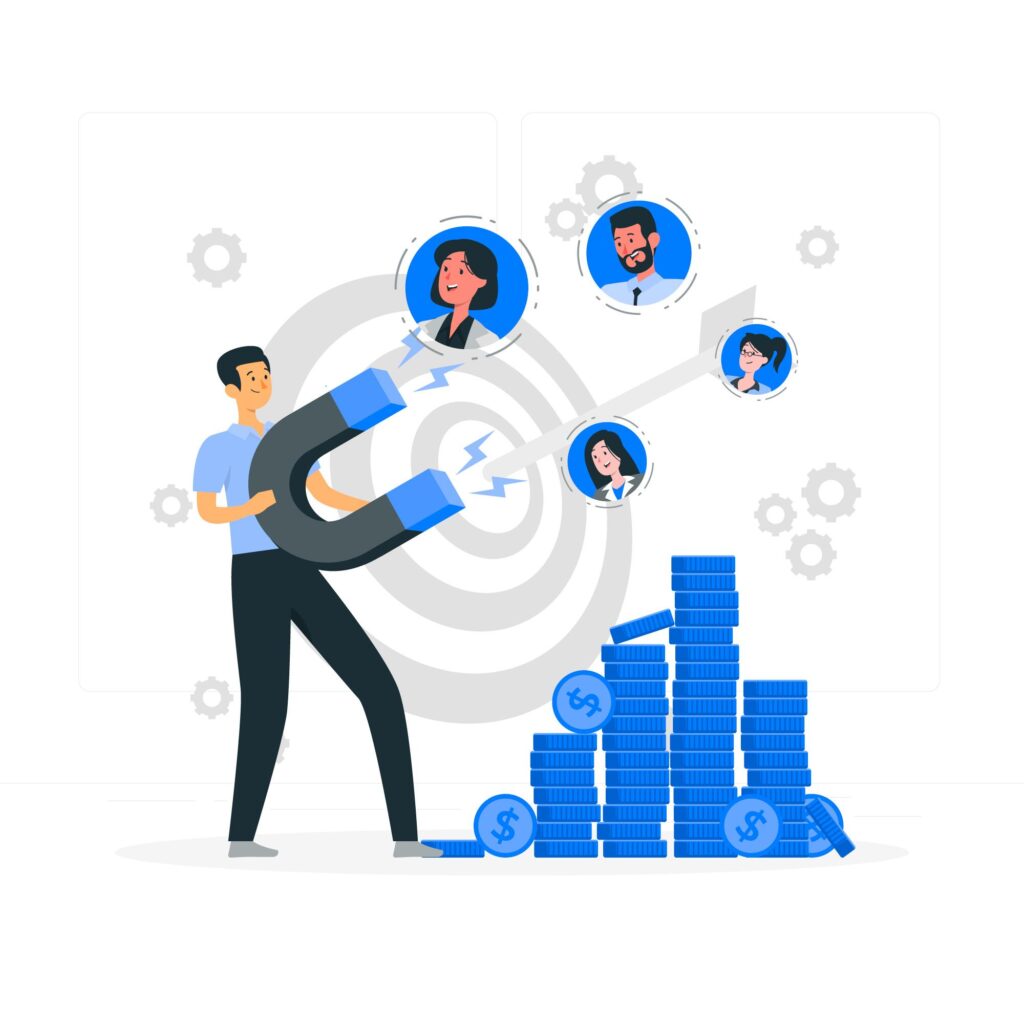Table of Contents
ToggleTable of Content
1: Introduction
* What is Lead Generation?
* Why is Lead Generation Crucial for Businesses?
2: Understanding the Basics of Lead Generation
* Definition of a Lead
* Types of Leads
(a) Marketing Qualified Leads (MQLs)
(b) Sales Qualified Leads (SQLs)
(c) Product Qualified Leads (PQLs)
(d) Service Qualified Leads (SQLs)
3: Lead Generation in the Digital Age
* Modern vs. Traditional Lead Generation
* Traditional vs. Digital Lead Generation
* The Impact of AI and Automation
4: Channels for Effective Lead Generation
* Content Marketing
* Social Media Marketing
* Email Marketing
* Search Engine Optimization (SEO)
* Pay-Per-Click (PPC) Advertising
* Webinars and Live Events
5: Strategies That Work in 2025
* Lead Magnets
* Landing Pages
* Chatbots and Conversational Marketing
* Retargeting Campaigns
* Influencer Collaborations
6: Lead Scoring and Qualification
* What is Lead Scoring?
* How to Implement Lead Scoring Effectively
7: Tools for Lead Generation
* CRM Tools
* Email Marketing Platforms
* Lead Capture Tools
* Automation Tools
8: Common Mistakes in Lead Generation
* Ignoring the Target Audience
* Poor Follow-Up Strategies
* Not Testing Campaigns
9: B2B vs B2C Lead Generation
* Key Differences
* Tactics Specific to Each
10: The Lead Generation Funnel
* Top of Funnel (TOFU)
* Middle of Funnel (MOFU)
* Bottom of Funnel (BOFU)
11: Measuring Lead Generation Success
* Important KPIs
* Using Analytics for Optimization
12: Outsourcing Lead Generation
* Pros and Cons
* When to Outsource
13: Future Trends in Lead Generation
* Personalization
* Predictive Analytics
* Privacy and Data Compliance
14: Real-Life Case Studies
* Case Study #1: SaaS Company
* Case Study #2: E-commerce Brand
15: Conclusion
* Final Thoughts
16: FAQs
1. Introduction

* What is Lead Generation?
Lead generation is the process of attracting potential customers (also called “leads”) and converting their interest into action—such as filling out a form, signing up for a newsletter, requesting a quote, or making a purchase. It’s the first and arguably most crucial step in the sales funnel, as it lays the foundation for turning a curious stranger into a loyal customer.
In today’s hyper-connected world, lead generation is more than just collecting email addresses. It’s about building relationships, providing value, and guiding potential buyers through their journey—starting from awareness to eventual conversion.
Think of lead generation like fishing. You don’t just cast your net randomly and hope for the best. You choose the right bait (content, offers, ads), find the right waters (your target audience), and use the right tools (landing pages, email, automation) to catch the kind of fish (leads) you want.
* Why is Lead Generation Crucial for Businesses?
Leads are like seeds. You plant them, nurture them, and with time, they grow into loyal customers. Effective lead generation means a full sales pipeline, increased revenue, and sustainable business growth. Without it, you’re just waiting for people to find you—and that’s not a strategy.

2. Understanding the Basics of Lead Generation
* Definition of a Lead
A lead refers to an individual who has expressed curiosity or intent toward what your business offers. It could be as simple as someone signing up for your newsletter, downloading your ebook, or requesting a demo.
* Types of Leads
(a) Marketing Qualified Leads (MQLs)
These leads have interacted with your marketing content, but they’re not quite prepared to speak with your sales team just yet. They’ve maybe downloaded a whitepaper or joined a webinar.
(b) Sales Qualified Leads (SQLs)
These folks are ready to buy. They’ve taken action that signals real interest—like asking for a pricing quote.
(c) Product Qualified Leads (PQLs)
Seen mostly in SaaS, PQLs are people who’ve used a free version of your product and now might upgrade.
(d) Service Qualified Leads
Customers who’ve indicated they want to upgrade or need additional services fall here.

3. Lead Generation in the Digital Age
* Modern vs. Traditional Lead Generation
Traditionally, lead generation was done via trade shows, direct mail, newspaper ads, and cold calls. While these still work in certain sectors, modern lead generation relies heavily on digital channels—SEO, content marketing, email campaigns, PPC, and social media.
Digital methods not only offer broader reach and lower costs but also provide detailed analytics to help businesses fine-tune their efforts.
* Traditional vs. Digital Lead Generation
Before the internet, lead gen meant cold calls, door-to-door sales, and print ads. Today, it’s blogs, landing pages, and social media ads. Digital gives us reach, speed, and data—all in real-time.
* The Impact of AI and Automation
AI tools can analyze user behavior, segment leads, and even write personalized emails. Automation keeps the process moving 24/7. It allows you to work more efficiently while still keeping things personal and relatable.

4. Channels for Effective Lead Generation
* Content Marketing
“Content is king,” they say—and for good reason. Blogs, ebooks, case studies, videos—all attract and nurture leads.
* Social Media Marketing
Platforms like Instagram, LinkedIn, and Facebook help target specific audiences. Think lead forms, DMs, and engaging stories.
* Email Marketing
Still one of the highest ROI channels. Create customized, benefit-rich emails that inspire your subscribers to become loyal buyers. Search Engine Optimization (SEO)
Get found organically. Optimize your website with the right keywords, meta tags, and high-quality content.
* Pay-Per-Click (PPC) Advertising
Google Ads and Facebook Ads let you target exactly who you want. Fast but can be costly—track ROI closely.
* Webinars and Live Events
Great for B2B. Show your expertise, offer value, and collect emails while you’re at it.

5. Strategies That Work in 2025
* Lead Magnets
Freebies like ebooks, cheat sheets, and tools in exchange for contact info.
* Landing Pages
High-converting landing pages are focused, clean, and persuasive. One goal, one action.
* Chatbots and Conversational Marketing
People love instant answers. Bots engage visitors and collect info 24/7.
* Retargeting Campaigns
Ever been stalked by a product after visiting their website? That’s retargeting—and it works!
* Influencer Collaborations
People trust people. A shoutout from the right influencer can bring in floods of new leads.

6. Lead Scoring and Qualification
* What is Lead Scoring?
You rank leads by how involved they are and how close they are to making a purchase. Assign points to actions like visiting a page or opening an email.
* How to Implement Lead Scoring Effectively
Use tools like HubSpot or Marketo. Work closely with your sales team to define what a “hot” lead looks like.

7. Tools for Lead Generation
* CRM Tools
Customer Relationship Management systems like Salesforce help track, manage, and follow up with leads.
* Email Marketing Platforms
Tools like Mailchimp, Active Campaign, or Convert Kit automate and personalize your emails.
* Lead Capture Tools
Think OptinMonster or HelloBar—tools that help you collect emails from visitors.
* Automation Tools
Tools like Zapier, Make (formerly Integromat), and HubSpot streamline your workflow by handling repetitive tasks automatically, cutting down on time and effort.
8. Common Mistakes in Lead Generation
* Ignoring the Target Audience
When your message targets everyone, it ends up resonating with no one. Know your buyer persona inside out.
* Poor Follow-Up Strategies
Leads go cold fast. Don’t delay follow-ups—set up email sequences and reminders.
* Not Testing Campaigns
A/B test everything—landing pages, headlines, CTAs. A strategy that succeeds for one company may fail for a different one.
9. B2B vs. B2C Lead Generation
* Key Differences
B2B is more logic-driven, with longer sales cycles. B2C is emotional and fast-paced.
* Tactics Specific to Each
B2B: Webinars, whitepapers, LinkedIn.
B2C: Social ads, influencer marketing, contests.

10. The Lead Generation Funnel
* Top of Funnel (TOFU)
Awareness stage—blogs, social posts, videos.
* Middle of Funnel (MOFU)
Consideration stage—ebooks, case studies, webinars.
* Bottom of Funnel (BOFU)
Decision stage—free trials, demos, pricing pages.
11. Measuring Lead Generation Success
* Important KPIs
Cost per lead (CPL)
Conversion rate
Lead-to-customer ratio
Bounce rate
Email open and click-through rates
* Using Analytics for Optimization
Use Google Analytics, HubSpot, or your CRM’s dashboard to track and refine campaigns. What gets measured gets improved.

12. Outsourcing Lead Generation
* Pros and Cons
Pros: Expertise, faster results, less time-consuming
Cons: Expensive, less control, quality concerns
* When to Outsource
If your internal team is stretched thin or lacking expertise—outsource. Just vet agencies properly.
13. Future Trends in Lead Generation
* Personalization
Tailored content converts better. Use data to personalize everything—emails, ads, landing pages.
* Predictive Analytics
AI predicts which leads are likely to convert. Focus your energy there.
* Privacy and Data Compliance
With GDPR and similar laws, you must collect and use data ethically. Transparency builds trust.

14. Real-Life Case Studies
* Case Study #1: SaaS Company
A mid-sized SaaS brand used content marketing, landing pages, and webinars to grow from 300 to 10,000 leads in one year. Lead scoring helped prioritize SQLs, improving close rates.
* Case Study #2: E-commerce Brand
A fashion brand collaborated with micro-influencers, used retargeting ads, and collected 50,000+ emails in 6 months. Their email campaigns brought in 3x ROI.
15. Conclusion
Lead generation isn’t a one-time task—it’s a continuous journey. Think of it like planting a garden. You need to prepare the soil (your website and brand), plant the seeds (your lead magnets and campaigns), water them consistently (through nurturing and follow-up), and keep the weeds out (by filtering low-quality leads).Whether you’re a startup aiming to build your first list or an established business scaling your outreach, mastering lead generation is non-negotiable. The techniques may evolve, the tools may get smarter, but the goal remains the same: connecting with the right people at the right time with the right message.Also, don’t underestimate the power of trust. In a world full of noise, the businesses that genuinely aim to help, educate, and solve problems will always stand out. Lead generation is no longer just a marketing function—it’s a value-driven, relationship-building effort.As we move deeper into 2025 and beyond, remember: success in lead generation comes to those who stay curious, adapt quickly, and always keep their customers at the center of their strategy. So go ahead—review your current lead gen tactics, explore new channels, optimize your funnels, and start converting more strangers into loyal customers. Your growth journey starts with one lead.
* Final Thoughts
Keep learning, keep testing, and always put your audience first. Whether you’re doing B2B or B2C, digital or traditional, the goal is simple: attract, engage, convert.Generating leads combines creativity with analytical precision. You need creativity to craft compelling offers and messages, and data-driven thinking to test, track, and optimize what works.Consistency beats intensity. There’s no need to tackle everything simultaneously. But you do need to show up regularly— publishing content, engaging your audience, and nurturing your leads over time.
Your audience is smarter than ever. They’ve seen every trick in the book. That’s why authenticity, transparency, and real value are your most powerful tools for generating qualified leads.No one-size-fits-all approach. A strategy that thrives for one company could fail completely for another. Always customize your strategies based on your goals, audience, and industry.Your lead generation strategy is never “done.” It’s a living, breathing part of your marketing. Keep testing, keep learning, and keep refining your process.
Value-first mindset wins. Before asking for an email or a sale, ask yourself: “Have I given them a reason to trust me?” Offer more value than you expect to receive, and the outcomes will improve.Don’t fear failure—fear stagnation. Some campaigns won’t work, and that’s okay. The key is to learn fast, pivot smart, and keep moving forward.
16. FAQs
1. What is the most effective lead generation method for small businesses ?
Content marketing combined with email follow-ups and social media engagement works best for small businesses.
2. How long does it typically take to see outcomes from lead generation activities ?
It depends on the channel. PPC can show results within days; SEO and content might take months.
3. What’s a good cost per lead ?
It varies by industry. For SaaS, under $100 can be good. For e-commerce, even $5 per lead might be excellent.
4. Are landing pages necessary ?
Absolutely! They focus your visitor’s attention and dramatically improve conversion rates.
5. Can I automate lead generation ?
Yes, with tools like HubSpot, Mailchimp, and Zapier, much of your lead generation can run on autopilot.
6. How do lead generation and demand generation differ from each other ?
Lead generation focuses on collecting contact information from interested individuals, while demand generation is about creating awareness and interest in your products or services. Consider demand generation as whetting the appetite, while lead generation is delivering the meal.
7. What steps can I take to enhance the quality of my leads?
Use better targeting, refine your buyer persona, create more personalized content, and implement lead scoring to filter out low-interest prospects. It’s about quality over quantity.
8. Does social media truly work for generating B2B leads ?
Absolutely! Especially platforms like LinkedIn. B2B decision-makers actively engage with content and industry discussions, making it a powerful channel for networking and lead nurturing.
9. How often should I update my lead generation strategy ?
At least quarterly. The digital space evolves quickly. New tools, changing algorithms, and customer behavior shifts mean your tactics need regular refreshment.
10. What role does mobile optimization play in lead generation ?
A huge one. Most users browse on mobile. Without mobile-friendly websites or forms, you’re simply driving potential leads away. Always design with mobile in mind.
🚀 Ready to turn traffic into customers?
Contact Admingle Media today for a free strategy session and discover how we can scale your lead generation efforts in 2025 and beyond.
📩 info@adminglemedia.com
For more information Join us Facebook